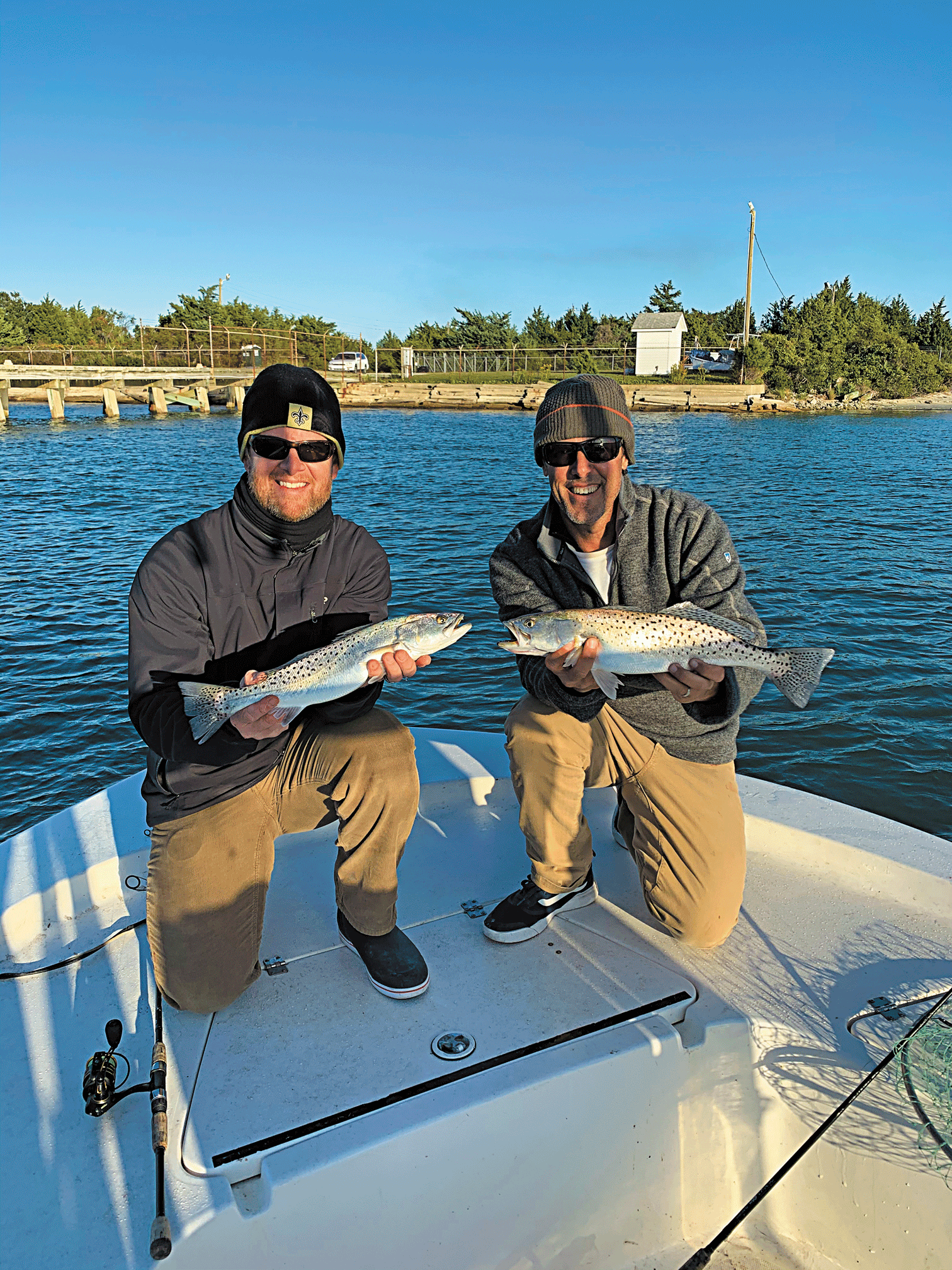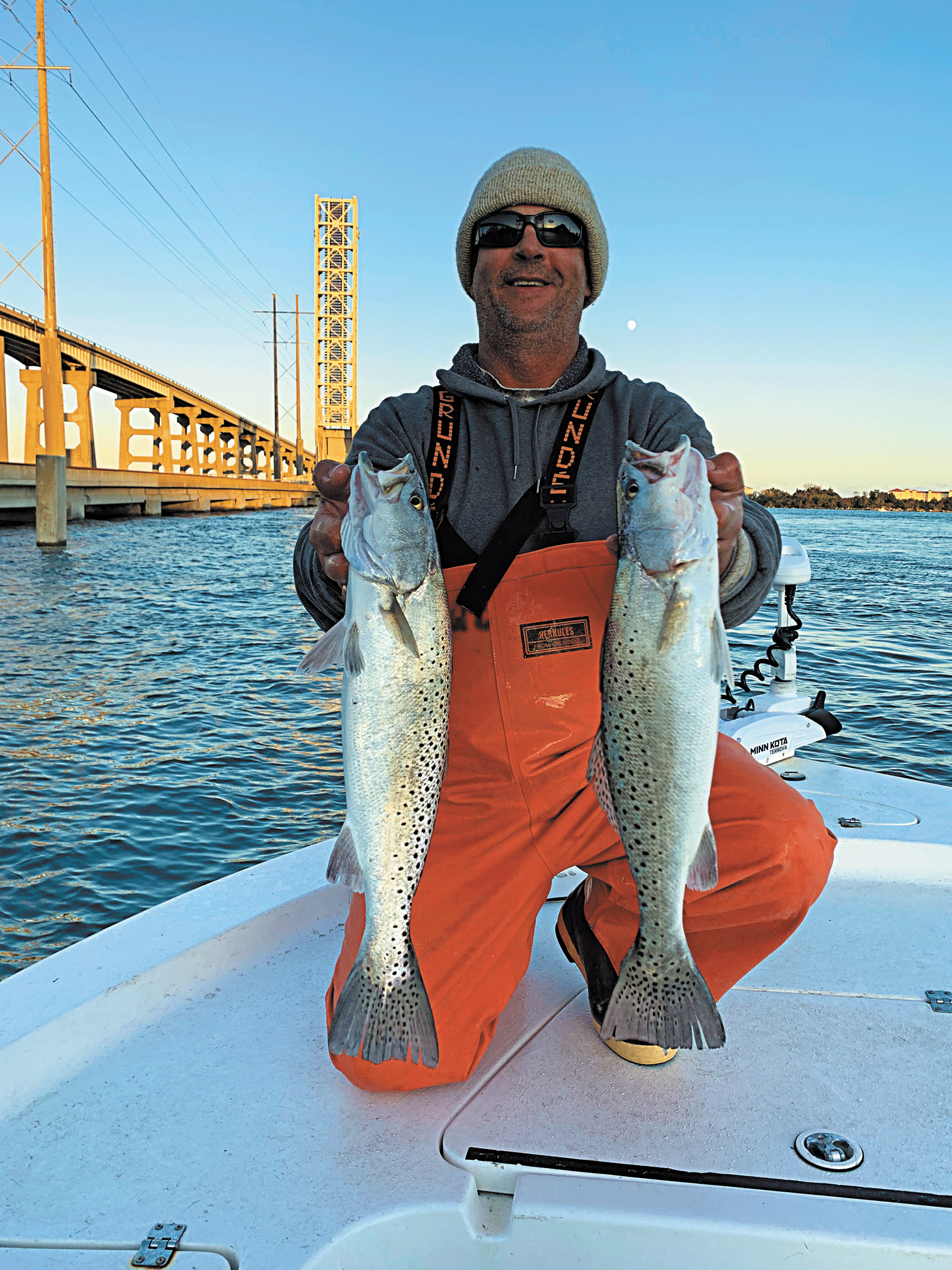Guide Time – Breakday Charters
Capt. Justin Ragsdale, of Breakday Charters out of the Morehead/Atlantic Beach area, bumped his boat over the shallow entrance to a Haystack-area creek. The tide was incoming but low, too low yet to target the other areas he really wanted to fish, places where he had racked up a 60-trout morning before picking me and Tom (brother-in-law) up around noon behind Freeman’s Bait & Tackle.
The three of us were hoping to post similar numbers in the afternoon, but Justin had coached us that the Haystacks should produce some specks but not likely in big numbers. Our chances were better when the tide was in a higher stage and we were in deeper water spots that were closer to the inlet, the more productive areas this time of year.

Tom Favor and Gary Hurley with a couple of trout they hooked off of a Radio Island dock. They were throwing pearl-colored Trout Tricks on BWC jig heads while fishing with Capt. Justin Ragsdale, of Breakday Charters out of the Morehead/Atlantic Beach area.
As for location, Justin believes, “Until the water gets down into the 50s, I’m going to concentrate on the fish (trout) that are near the ocean. Trout are generally deeper water fish and they are generally in moving water, so I’m going to target these fish that are staging to go into the ocean.”
“As long as the water is above 55 degrees,” he continued, “I’ll stay in these areas. Once we get into 55 and lower, then I’m going to start moving back into the marshes and into the calmer waters that have less tidal waters.”
On optimum tide, Justin explained, “As a general rule, I like the last couple of hours of incoming, through the slack flood, and then the first couple or three hours of the outgoing tide.”
So the Haystacks, on this day, was to be treated as a warmup. Justin used the anchor feature on his trolling motor and handed Tom and I each a rod with a soft plastic tied on.

Capt. Justin Ragsdale, of Breakday Charters out of the Morehead/Atlantic Beach area, with two of the numerous keeper trout hooked on an afternoon half day trip. He was targeting deeper water near the ocean and throwing soft plastics.
“I like anything Z-Man,” he told us, “a Trout Trick fan all the way. In clean water, I’m going to go with my whites and the pearls. You get into dirtier water, I might start picking up the chartreuses and the electric chickens. This year, the pearl has been working in dirty and clean water.”
There was some wind, but the creek Justin had us in was positioned to knock down that wind. That was part of his plan for the warmup, as Justin has locations—coves, rivers, and creeks—where he can get his clients out of the late fall or winter winds no matter the direction.
The blocked wind made it easier for Tom and me to cast out the lighter jig head tied on.
“As a general rule, 3/16 is my go to,” he said as we targeted a grass bank with a surface ripple from a submerged oyster bed on the other side of our little creek. “I want just as much weight that will let me make contact with the bottom. The least amount of weight to still make contact is where I like to be.”
“Most of these fish are laying with their belly close to the bottom, where they have frictional resistance to the current. These fish are looking up or looking straight into the current. If the jig head is too heavy, it doesn’t flow with the current. It doesn’t ride with the current.”
Justin also had an opinion on the type of 3/16 oz. jig head he likes. “I like the cross-eyed Blue Water Candy jig head,” he said, holding up one for Tom and I to more closely inspect. “It has a barb plus a ring collar, so it holds the new soft plastics really well. The Z-Mans don’t slip off, the Gulps don’t slip off, and it comes with a really sharp hook right out of the box.”
The trout bite was far from “hot,” but we found some fish. And an encouraging detail was that all of our fish were 17+”. As Justin described, these are all those spikes that everyone was catching last year. The lack of a true fish kill event over the past winter had the trout in both good numbers and sizes this year.
Mixed in with our keeper-sized trout hookups was some by-catch. Tom found a small red drum and I managed to bring in a couple of keeper flounder, or at least what would have been keeper flounder without the closure. The lizardfish played with us, too, but mostly we enjoyed the pleasure of setting the hook after feeling the slam of a classic trout bite.
Idling back out of our Haystack creek, we no longer bumped the bottom. The tide had come in enough for Justin to make the call to head to his deeper water spots closer to the ocean. Again he used the spot lock feature, this time to position us off of some Radio Island docks.
Tom and I stood shoulder to shoulder in the bow of the boat, each of us still throwing out a pearl Trout Trick, and we started to fan cast the area to try and find the fish that Justin had been on in thethat morning.
This was exactly the habitat that Justin likes for targeting trout in November. We were in deeper water (anywhere in the 5-15’ range), targeting any kind of structure (docks or sea walls), and the area was holding bait, which we could seeon the surface in pods moving casually through the area, as well as scattering and showering when being targeted from below.
I came tight to our first trout, and it was another 17+” fish. Then I hooked our second, our third, our fourth, and so on. Tom, standing beside me while casting to the same location and throwing the same soft plastic/jig head combo, couldn’t help to be frustrated that he had yet to hook a single trout off this dock.
Sometimes it’s just not your day. We’ve all been there—you’re doing what everyone else is doing, but for some reason, everyone else is catching fish and you’re not. Maybe it’s just “luck,” or rather “bad luck,” or maybe there’s a more practical explanation. For Tom on this day, there was a more practical explanation.
Tom was casting, flipping the bail when the soft plastic hits the water’s surface, and then slowly retrieving the bait while giving it some “jerk” and “pop” action on the slow retrieve.
However, I was casting and flipping the bail when the soft plastic hits the water’s surface, but then I was waiting a 10-12 second count before applying any action whatsoever. And then even after the 10-12 second count, I rarely did any retrieve. The tide was going away from the boat in the direction of the bait, so the tide alone was keeping my line tight. I was hardly doing any retrieve, mostly just some very slight twitches and bumps. I was letting as the bait flow and ride with the current, just as Justin had instructed.
Slowing down your retrieve, and I mean really slowing down your retrieve, can be a hard task, especially when you’re seeing people hook fish and you’re anxious to hook your own fish. Tom did better once he slowed down, and he did start to set the hook on his own 17+” trout, but still his retrieve was more of a slow and steady retrieve, as opposed to barely any retrieve at all. So while Tom’s hookup numbers improved, they still stayed low, comparatively.
We left the fish still biting at our Radio Island dock to try and find bigger fish at a nearby seawall. Most of our fish at Radio Island were 17-19”. There wasn’t a single under-sized trout, but we did land a handful just above the 20” mark.
I asked Justin about trout of similar sizes swimming together and the chances of finding bigger trout. He replied, “If you’re consistently catching 13, 14, and 15-inch trout, then that’s probably all you’re going to catch there. That’s not to say you can’t pull a 4-pounder out of the middle of them, but when I start to catch fish that have an average size of 18-inches plus, that’s when you really have a good chance of hanging into that 5-pound, 25-inch citation fish.”
Our seawall offered almost identical results to Radio Island. We didn’t catch a single under-sized trout, most of our fish were 17-18”, and we found a couple closer to 20” in the mix. There was one difference, though. Maybe the short boat ride offered Tom just enough time for reflection, because at the seawall, he truly slowed down his retrieve to the bare minimum. Now, with the sun starting to set indicating it was time to head back to Freeman’s, Tom was catching trout for trout with us.
The no wake zone near the Morehead boat basin gave me time to hear more of Justin’s thoughts on late fall and winter trout fishing. He shared, “We had a great afternoon, but there’s nothing like that first early morning bite. Most predator fish’s eyes adjust to light quicker than the prey do, so they’re always going to take advantage of those minnows that are blind.”
When I asked him to share any other insights, he offered, “If it’s a place you go to and have caught fish before, sometimes you have to wait that tide out a half hour or hour, and all of a sudden the fish that are there, boom, they turn on. Also, Pro-Cure. The trout definitely hold on longer. I don’t know if the flavor matters. I just buy the inshore saltwater formula.”
Capt. Justin Ragsdale, of Breakday Charters, has been effective for several years now putting clients in the Morehead/Atlantic Beach area on fish, and his success has equated to a Breakday fleet. He now offers trips on three different boats: a 22′ Tidewater bayboat, a 23′ Dusky deep vee center console, and a 38′ custom-built North Carolina Sportfisherman.
Justin will be catching trout, and ICW redfish, all winter long, and then in the spring he targets just about any species swimming inshore, nearshore, or offshore. You can find out more information on all of his offerings by visiting www.breakdaycharters.com, or by calling (252) 732-0990.
If you decide on a winter trout trip, though, don’t be Reverend Jim in the “Driver’s Test” episode of Taxi when he asks what a yellow light means (please Google on YouTube so that my very dated reference makes any sense). Make sure you correctly hear the intention of the words “slow down.”
